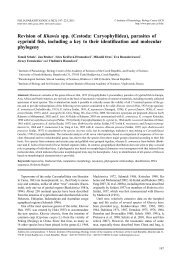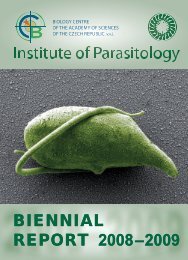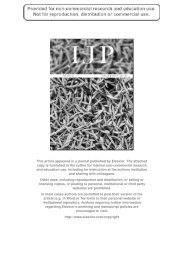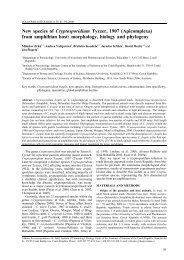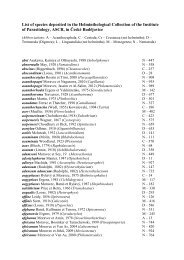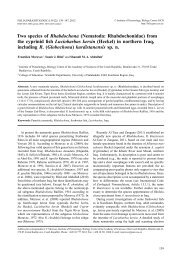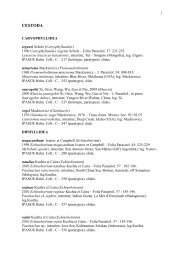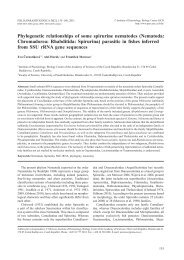Coccidia of rabbit: a review
Coccidia of rabbit: a review
Coccidia of rabbit: a review
Create successful ePaper yourself
Turn your PDF publications into a flip-book with our unique Google optimized e-Paper software.
Table 4. Anticoccidial drugs efficient and nonefficient against <strong>rabbit</strong> coccidiosis.<br />
a) efficient<br />
Drug Reference<br />
decoquinate Coudert 1978<br />
diclazuril Vanparijs et al. 1989a, b<br />
formolsulphathiazol * Coudert 1978<br />
metichlorpindol/methylbenzoquate<br />
(Lerbek)<br />
Although anticoccidial drugs can assure relatively reliable<br />
and cheap coccidiosis control, their use is not well<br />
accepted by public. Moreover, they have some disadvantages,<br />
such as negative impact on the environment because<br />
<strong>of</strong> their excretion in faeces, which are subsequently<br />
used as fertiliser. The drugs are also absorbed into the<br />
meat, having a negative impact on this product. Application<br />
<strong>of</strong> some <strong>of</strong> these drugs is also risky due to their toxicity<br />
for hosts. Moreover, resistance to anticoccidial drugs<br />
has appeared in chicken and <strong>rabbit</strong> coccidia. Vaccination<br />
with live attenuated lines <strong>of</strong> coccidia is another method<br />
for the control <strong>of</strong> coccidiosis, which is becoming popular<br />
in farming <strong>of</strong> domestic fowl.<br />
8.3. vaccInatIon<br />
Precocious lines, exhibiting significantly reduced pathogenicity,<br />
were selected in six <strong>rabbit</strong> coccidia, including<br />
the species relevant in terms <strong>of</strong> pathogenicity. Perhaps an<br />
162<br />
Peeters et al. 1979b, 1982, 1983<br />
Joyner et al. 1983<br />
Varga 1982<br />
Coudert 1978<br />
monensin ** Fitzgerald 1972<br />
Gwyther and Dick 1976<br />
Sambeth and Raether 1980<br />
narasin Peeters et al. 1981<br />
robenidine ** Coudert 1978<br />
Peeters et al. 1979a, 1980, 1983<br />
Peeters and Halen 1980<br />
salinomycin Lämmler and Hein 1980<br />
Coudert 1981<br />
Kutzer et al. 1981<br />
Okerman and Moermans 1980<br />
Peeters et al. 1982<br />
Varga 1982<br />
Sambeth and Raether 1980<br />
sulphadimethoxine * Coudert 1981<br />
sulphadimidine/diaveridine * Daněk et al. 1978<br />
sulphaquinoxaline * Chapman 1948<br />
Joyner et al. 1983<br />
Kutzer et al. 1981<br />
sulphaquinoxaline/<br />
pyrimethamine *, Gómez-Bautista and Rojo-Vázquez 1986<br />
**<br />
toltrazuril Peeters and Geeroms 1986<br />
* sulphonamides (see the remark in the text); ** contradictory results (see<br />
part b)<br />
b) less efficient or nonefficient<br />
Drug Reference<br />
amprolium Fitzgerald 1972<br />
Joyner et al. 1983<br />
amprolium/ ethopabate Peeters and Halen 1979a<br />
buquinolate Bedrník and Martinez 1976<br />
clopidol Bedrník and Martinez 1976<br />
furazolidone Bedrník and Martinez 1976<br />
lasalocid Sambeth and Raether 1980<br />
methylbenzoquate Joyner et al. 1983<br />
Peeters and Halen 1979b<br />
Bedrník and Martinez 1976<br />
metichlorpindol Joyner et al. 1983<br />
Peeters and Halen 1979a, 1980<br />
Peeters et al. 1980<br />
monensin ** Coudert 1978<br />
nicarbazine Coudert 1978<br />
Bedrník and Martinez 1976<br />
nitr<strong>of</strong>urazone/furazolidone Coudert 1978<br />
robenidine **<br />
Joyner et al. 1983<br />
(liver coccidiosis) Peeters et al. 1982<br />
sulphaquinoxaline/<br />
pyrimethamine *, **<br />
Peeters et al. 1980<br />
Bombeke et al. 1977<br />
* sulphonamides (see the remark in the text); ** contradictory results (see<br />
part a)<br />
exception is the relatively rare species E. irresidua and<br />
E. stiedai.<br />
Vaccination trials were preformed by Drouet-Viard et<br />
al. (1997a, b) with a precocious line <strong>of</strong> E. magna. Vaccination<br />
both per os or using spray dispersion <strong>of</strong> oocysts<br />
into nest boxes gave satisfactory results. However, the selection<br />
<strong>of</strong> attenuated lines is still far from the development<br />
<strong>of</strong> a vaccine, including testing <strong>of</strong> its efficacy, pathogenicity<br />
and safety, registration, production and distribution<br />
to customers. To my knowledge, nobody in all over the<br />
world is currently purposing to continue this work due<br />
to the considerable financial means required. It may be<br />
supposed that other more sophisticated methods <strong>of</strong> coccidiosis<br />
control will eventually be introduced into the<br />
poultry industry and perhaps later in <strong>rabbit</strong> production as<br />
well. Development <strong>of</strong> efficacious methods, alternative to<br />
continuous medication with anticoccidial drugs, <strong>of</strong> <strong>rabbit</strong><br />
coccidiosis control, is a challenge for future research<br />
work.<br />
Acknowledgements. This work was supported by the grant No.<br />
524/05/2328 <strong>of</strong> the Grant Agency <strong>of</strong> the Czech Republic and by<br />
the research project <strong>of</strong> the Intitute <strong>of</strong> Parasitology, BC ASCR<br />
(Z60220518).



